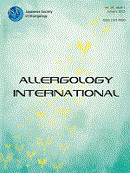70 巻, 2 号
選択された号の論文の22件中1~22を表示しています
- |<
- <
- 1
- >
- >|
Editorial
-
2021 年 70 巻 2 号 p. 161-162
発行日: 2021年
公開日: 2021/04/14
PDF形式でダウンロード (215K)
Invited Review Articles
Review Series: Immunological Memory and Allergic Diseases
-
2021 年 70 巻 2 号 p. 163-168
発行日: 2021年
公開日: 2021/04/14
PDF形式でダウンロード (1046K) -
2021 年 70 巻 2 号 p. 169-173
発行日: 2021年
公開日: 2021/04/14
PDF形式でダウンロード (967K) -
2021 年 70 巻 2 号 p. 174-180
発行日: 2021年
公開日: 2021/04/14
PDF形式でダウンロード (948K)
Review Articles
-
2021 年 70 巻 2 号 p. 181-189
発行日: 2021年
公開日: 2021/04/14
PDF形式でダウンロード (765K) -
2021 年 70 巻 2 号 p. 190-200
発行日: 2021年
公開日: 2021/04/14
PDF形式でダウンロード (1781K)
Original Articles
-
2021 年 70 巻 2 号 p. 201-207
発行日: 2021年
公開日: 2021/04/14
PDF形式でダウンロード (544K) -
2021 年 70 巻 2 号 p. 208-214
発行日: 2021年
公開日: 2021/04/14
PDF形式でダウンロード (676K) -
2021 年 70 巻 2 号 p. 215-222
発行日: 2021年
公開日: 2021/04/14
PDF形式でダウンロード (1497K) -
2021 年 70 巻 2 号 p. 223-228
発行日: 2021年
公開日: 2021/04/14
PDF形式でダウンロード (544K) -
Mortality and risk factors on admission in toxic epidermal necrolysis: A cohort study of 59 patients2021 年 70 巻 2 号 p. 229-234
発行日: 2021年
公開日: 2021/04/14
PDF形式でダウンロード (537K) -
2021 年 70 巻 2 号 p. 235-243
発行日: 2021年
公開日: 2021/04/14
PDF形式でダウンロード (2009K) -
2021 年 70 巻 2 号 p. 244-251
発行日: 2021年
公開日: 2021/04/14
PDF形式でダウンロード (3311K)
Letters to the Editor
-
2021 年 70 巻 2 号 p. 252-254
発行日: 2021年
公開日: 2021/04/14
PDF形式でダウンロード (372K) -
2021 年 70 巻 2 号 p. 255-257
発行日: 2021年
公開日: 2021/04/14
PDF形式でダウンロード (616K) -
2021 年 70 巻 2 号 p. 258-261
発行日: 2021年
公開日: 2021/04/14
PDF形式でダウンロード (1149K) -
2021 年 70 巻 2 号 p. 262-265
発行日: 2021年
公開日: 2021/04/14
PDF形式でダウンロード (499K) -
2021 年 70 巻 2 号 p. 266-268
発行日: 2021年
公開日: 2021/04/14
PDF形式でダウンロード (421K) -
2021 年 70 巻 2 号 p. 269-270
発行日: 2021年
公開日: 2021/04/14
PDF形式でダウンロード (956K) -
2021 年 70 巻 2 号 p. 271-273
発行日: 2021年
公開日: 2021/04/14
PDF形式でダウンロード (463K) -
2021 年 70 巻 2 号 p. 274-276
発行日: 2021年
公開日: 2021/04/14
PDF形式でダウンロード (701K)
Corrgiendum
-
2021 年 70 巻 2 号 p. 277
発行日: 2021年
公開日: 2021/04/14
PDF形式でダウンロード (503K)
- |<
- <
- 1
- >
- >|
